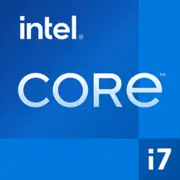Intel Core i7-11700K

Intel Core i7-11700K in 2025: Is it Worth Buying the "Veteran" Rocket Lake?
Architecture, Performance, and Relevance of the Processor for Modern Tasks
Key Characteristics: Rocket Lake Against Modern Standards
The Intel Core i7-11700K, released in 2021, became part of the Rocket Lake-S line. Despite its age, it remains relevant for a range of scenarios due to its high clock frequency and optimized architecture.
Architecture and Manufacturing Process
- 14 nm (Intel SuperFin): By 2025, a 14 nm manufacturing process looks archaic compared to 5 nm (AMD Ryzen 8000) and 4 nm (Apple M3) solutions. However, Intel has managed to get the most out of this technology: a turbo frequency of up to 5 GHz and 8 cores (16 threads) provide high single-thread performance.
- Cypress Cove: An improved microarchitecture compared to previous generations (e.g., Comet Lake), featuring an IPC (Instructions Per Cycle) increase of up to 19%.
Performance
- Geekbench 6: 2207 (single-threaded) and 7901 (multi-threaded). In comparison, the Ryzen 7 5800X scores around 2100/8100, while the more modern Ryzen 5 7600X scores 2700/11500. The i7-11700K outperforms the 5800X in single-thread tasks but falls short in multi-threaded workloads.
- Cache: 16 MB L3 is sufficient for gaming but less than competitors (e.g., Ryzen 7 7700X has 32 MB).
Key Features
- Intel UHD Graphics 750: Integrated graphics for emergencies (e.g., in case of a discrete GPU failure).
- Support for PCIe 4.0: 20 lanes, which is relevant for fast NVMe storage solutions and modern graphics cards.
- Technologies: Intel Deep Learning Boost, support for AVX-512 (useful for AI tasks and scientific computations).
Compatible Motherboards: What to Choose in 2025?
The i7-11700K requires the LGA 1200 socket and 500 series chipsets.
Chipsets
- Z590: The best choice for overclocking (e.g., ASUS ROG Maximus XIII Hero). Supports PCIe 4.0 and has an unlocked multiplier.
- B560: Budget-friendly option with limited overclocking (MSI B560 Tomahawk). Supports memory up to 3200 MHz.
- H510: For office builds (Gigabyte H510M S2H). No overclocking or PCIe 4.0 support.
Tip: By 2025, new LGA 1200 motherboards are no longer produced, but they can be found in the secondary market priced at $80–150 (Z590 boards up to $200).
Memory: Only DDR4
The i7-11700K supports DDR4 up to 3200 MHz (non-overclocked). In the era of DDR5, this limitation seems outdated, but:
- Affordability: DDR4 is cheaper ($35–50 for 16 GB compared to $70–100 for DDR5).
- Latencies: Low timings (CL14–16) help compensate for the lower frequency.
Example: A G.Skill Ripjaws V 32 GB (3600 MHz, CL16) kit costs $90.
Power Supply: How Many Watts Are Needed?
- TDP 125W: While overclocked, the consumption reaches 200–220W.
- Recommendations:
- Without overclocking: A PSU from 550W (e.g., Corsair CX550M — $65).
- With overclocking: From 650W with 80+ Gold certification (Seasonic Focus GX-650 — $110).
- Important: Choose power supplies with a separate 8-pin cable for the CPU.
Pros and Cons of the i7-11700K in 2025
Pros
- High Gaming Performance: A frequency of 5 GHz remains relevant for FHD and 2K gaming (e.g., Cyberpunk 2077 — 90–110 FPS on Ultra with RTX 4070).
- Availability: The processor is priced at $220–250 (new), which is cheaper than the Ryzen 7 7700X ($350).
- Proven Platform: Stability and maturity of drivers.
Cons
- Energy Efficiency: High power consumption compared to Ryzen 7000 (up to 2x difference under load).
- Lack of PCIe 5.0 and DDR5: No compatibility with the latest SSDs and memory.
- Heat: Requires a powerful cooler (e.g., Noctua NH-D15 — $110).
Usage Scenarios
Gaming
The processor handles AAA titles well in combination with GPUs like the RTX 4070 and above. Example:
- Call of Duty: Warzone 2.0: 140–160 FPS (1080p, High).
- Microsoft Flight Simulator 2024: 60–70 FPS (1440p, Ultra).
Work Tasks
- Rendering (Blender): 25–30% slower than the Ryzen 9 7900X, but faster than the i5-12400F.
- Programming: Comfortable work in IDEs and Docker.
Multimedia
- 4K Editing (Premiere Pro): Use GPU acceleration to mitigate core count drawbacks.
- Streaming: NVENC on Nvidia graphics cards reduces CPU load.
Comparison with Competitors
AMD Ryzen 7 5800X
- Pros: Energy efficiency, support for PCIe 4.0.
- Cons: Weaker in single-threaded tasks.
- Price: $240–270.
Intel Core i5-13600K
- Pros: 14 cores (6P+8E), DDR5, PCIe 5.0.
- Cons: More expensive ($300).
Conclusion: The i7-11700K is a good choice for a budget build focused on gaming.
Practical Assembly Tips
1. Cooling: Minimum tower cooler (DeepCool AK620 — $65).
2. Motherboard: ASUS TUF Gaming Z590-Plus (good VRM for overclocking).
3. Storage: Samsung 980 Pro 1 TB (PCIe 4.0 — $120).
4. Case: With good ventilation (Lian Li Lancool 216 — $100).
Final Conclusion: Who Should Choose the i7-11700K?
This processor is worth considering if:
- Budget is limited, but high gaming performance is needed.
- You already have DDR4, and don’t want to switch to DDR5.
- You have no plans for an upgrade in the next 2–3 years.
Alternatives: For future upgrades, you might consider the Ryzen 5 7600X or Core i5-14600K.
In 2025, the i7-11700K is a reliable workhorse for gamers and users who value stability. However, if you're planning to move to new technologies (PCIe 5.0, DDR5), consider modern models.
Basic
CPU Specifications
Memory Specifications
GPU Specifications
Benchmarks
Compared to Other CPU
Share in social media
Or Link To Us
<a href="https://cputronic.com/cpu/intel-core-i7-11700k" target="_blank">Intel Core i7-11700K</a>